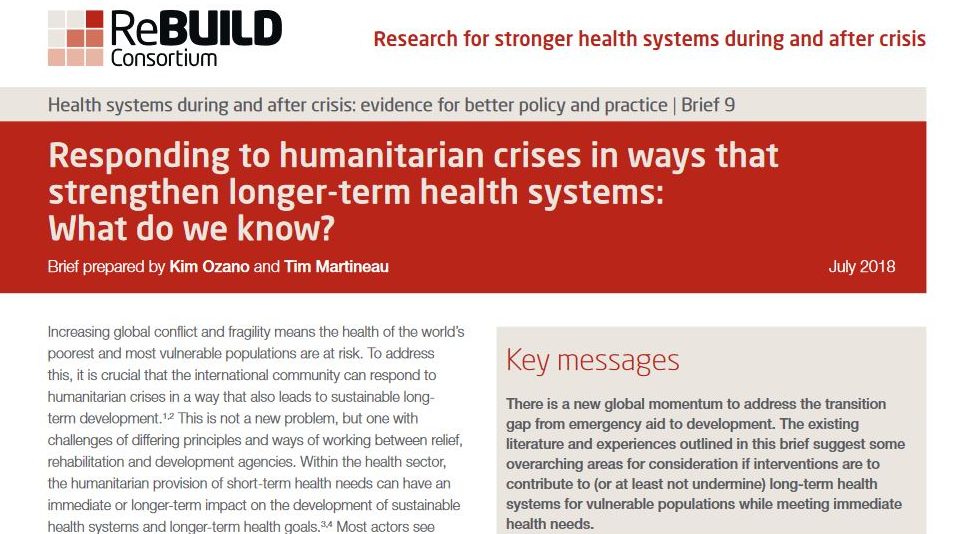
Responding to humanitarian crises in ways that strengthen longer-term health systems: What do we know?
Brief prepared by Kim Ozano and Tim Martineau to inform thinking on long-term health systems strengthening in humanitarian settings.
You can access the full briefing paper here.
Increasing global conflict and fragility means the health of the world’s poorest and most vulnerable populations are at risk. To address this, it is crucial that the international community can respond to humanitarian crises in a way that also leads to sustainable long-term development[i],[ii] This is not a new problem, but one with challenges of differing principles and ways of working between relief, rehabilitation and development agencies. Within the health sector, the humanitarian provision of short-term health needs can have an immediate or longer-term impact on the development of sustainable health systems and longer-term health goals.[iii],[iv] Whilst most actors see the value in achieving Sustainable Development Goals (SDGs) in conflict and crisis affected settings, there are tensions between delivering emergency services in a timely and flexible manner and achieving longer term, country led, health goals.[v] Whilst there are efforts to improve connectivity between humanitarian and development actors through better coordination, shared outcomes, financing streams and engaging in longer term planning,[vi] differences in working principles, mandates and cultures present challenges to achieving this.2,[vii] In addition, protracted crisis situations such as South Sudan and Syria, require humanitarian and development sectors to act simultaneously.2,5,7,[viii] This brief outlines what is known about how to respond to humanitarian crises in ways that also contribute to subsequent stronger health systems.
[i] Otto R, Weingärtner L. (2013) Linking Relief and Development: More than old solutions for old problems? IOB Study no. 380. Netherlands: Ministry of Foreign Affairs; 2013. http://bit.ly/2JdBXbj
[ii] Steets J, Preysing D, Shapiro G. (2011) Donor Strategies for Addressing the Transition Gap and Linking Humanitarian and Development Assistance: A Contribution to the International Debate. Berlin: Global Public Policy Institute. http://bit.ly/2N3tY30
[iii] Jones A, Howard N, Legido-Quigley H. (2015) Feasibility of health systems strengthening in South Sudan: a qualitative study of international practitioner perspectives. BMJ Open 5(12). http://bit.ly/2L5DKRz
[iv] Martineau T. et al. (2017) Leaving no one behind: lessons on rebuilding health systems in conflict- and crisis-affected states. BMJ Global Health 2(2). http://bit.ly/2JecIWn
[v] De Castellarnau M, Stoianova V. (2018) Bridging the emergency gap: Reflections and a call for action after a two-year exploration of emergency response in acute conflicts. Barcelona: Médecins Sans Frontières. http://bit.ly/2NGLj2Q
[vi] Affun-Adegbulu C. et al. (2018) Contexts and Crises: Evidence on Coordination and Health Systems Strengthening in Countries under Stress: a literature review and some reflections on the findings. Antwerp: Health Policy Unit, Institute of Tropical Medicine, Belgium. http://bit.ly/2m7FXRJ
[vii] Kocks A. et al. (2018) Building bridges between international humanitarian and development responses to forced migration. German Institute for Development Evaluation and The Swedish Expert Group for Aid Studies. http://bit.ly/2L8H3HG
[viii] Downie R. (2012) The State of Public Health in South Sudan: Critical Condition. Washington: Center for Strategic and International Studies. CSS Global Health Policy Centre. http://bit.ly/2KXuu5p